
People
Goal
Discriminative feature selection for hidden Markov Models in sequence
classification.
Introduction
Speech
recognition, gesture recognition, DNA analysis and many other pattern
recognition tasks for time-series data are sequence classification problems,
which predict of a single label for an entire sequence. The most successful
technique for sequence classification is the hidden Markov Model (HMM). The
recognition accuracy and efficiency of HMMs can be improved with discriminative
features. Traditional feature selection methods require the data being
independently and identically distributed (i.i.d.), but time sequences usually
contain strong temporal correlation between the adjacent observation frames.
Furthermore, features in time sequences may be "sometimes informative", that is,
discriminative only in some segments of a sequence. In this research, we propose
Segmentally-Boosted HMMs (SBHMMs), which is able to address the problems of both
temporal correlation and segmentally-informative features by assuming "piecewise
i.i.d." Experiments show that the SBHMMs consistently improve traditional HMM
recognition in American Sign Language recognition, human gait identification,
lip reading and speech recognition. The reduction of error ranges from 17% to 70%.
Conditional Random Fields [Lafferty, et.al., 2001] or
Tandem models [Hermansky, et.al., 2000] require a state-level labeling by human
or forced alignment. In practice, such labeling may not be possible. For example,
to recognize the sign brother, how
can the human labeler precisely supervise the training for the first
state when he does not even know the states meaning or how many
states comprise the sign?
Without such labeling, the
discriminative feature selection will be limited to the level of the entire signs
or phonemes. In contrast, SBHMMs are truely designed for
sequence classification, in which the sub-sequence components are
unknown, and our experiments show that the feature selection
at the sub-sequence (state) level achieves superiour performance than that at the sequence level.
Approach
-
Train HMMs for input sequences
(the example below is the sign "sister" in ASL).
-
Label each frame automatically with its most likely state
computed from the Viterbi decoding.
|
 |
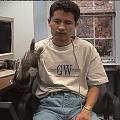 |
 |
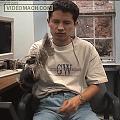 |
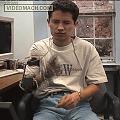 |
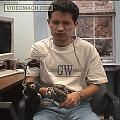 |
|
state 1 |
state 1 |
state 1 |
state 2 |
state 2 |
state 3 |
-
Train
AdaBoost for this labeling.
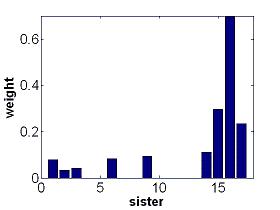 |
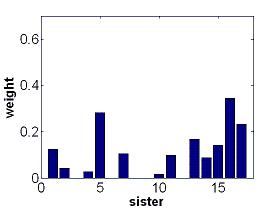 |
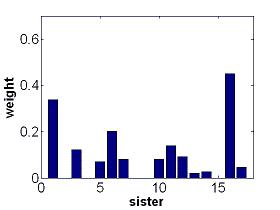 |
|
feature weights for state 1 |
feature weights for state 2 |
feature weights for state 3 |
|
AdaBoost constructs classification ensembles for
each state of every HMM. The ensembles linearly combine the decision
stumps over 17 input features (accelerometer readings). The weights for
the combination, which tell the importance of the features, are greedily
chosen to achieve high accuracy in separating one state from all the
other states (in the same HMM and in different HMMs). This figure show that
our feature selection technique assigns more weight to the accelerometer
readings number 15-17, the shoulder elevation, in state 1. This is consistant with the
linguistics of ASL.
|
-
The new
feature space V is the output space of the AdaBoost ensembles.
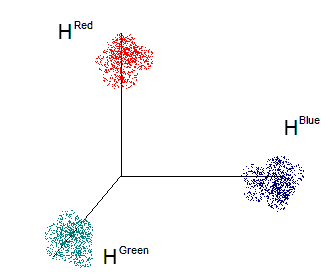 |
|
In real world applications, the dimension of V is the total number
of classifiers, which is also the total number of the states in all HMMs.
This figure shows a much simpler example, in which we only have three classes: Red,
Green, and Blue. Any sample x in the original space is converted/projected to coordinate
(H^(Red)(x), H^(Green)(x), H^(Blue)(x)). In the ideal (separable) situation, the samples with the same
state label will be at the same corner in V, as shown in the figure. In the noisy (inseparable)
situation, the aggregation property of the margins, which is described in [Yin, et.al., 2008],
still drives the samples towards the "ideal" direction.
The new feature space is more discriminative due to the feature selection procedure, and it fits
the Gaussian observation model better in our experiments. For details please see [Yin, et.al., 2008].
In cases where there are too many states,
unsupervised dimension reduction methods, such as PCA can be employed. We did not use such method
in computing V for the evaluation reported in [Yin, et.al., 2008].
|
-
Train
new HMMs in V. Those HMMs have higher accuracy due to the discriminative
features.
Data
-
Georgia Tech Speech Reading Data
Description: Continuous audio-visual speech recognition
data, audio captured by one microphone at 16kHz and visual markers captured by
Motion Capture devices at 120Hz.
| Total Length |
30m45s |
MoCap Rate |
120Hz |
| Training Data |
24m42s |
Testing Data |
06m03s |
| Total Sentences |
275 |
Total Phones |
8468 |
| Total Phonemes |
39 |
Total Samples |
> 200,000 |
Download:
Compressed file (84MB): gtsr.rar
-
Georgia Tech Gait Recognition Data
Description: Gait identification data captured by Motion
Capture (MoCap) devices at 120Hz.
It contains 22 tracker readings for 15 subjects. We
used three leg-related readings of the first five subjects following the convention in
[Kim and Pavlovic, 2006]
Download:
link
(via FTP)
-
MIT American Sign Language Recognition Data
Description: Continuous ASL data captured by video
cameras mounted on the hat.
It contains 500 five-sign sentences composed
of 40 different signs by one subject.
Download:
starner97.zip from
Contextual Computing Group (CCG) at Georgia Tech
-
Georgia Tech American Sign Language Recognition Data
Description: Continuous ASL data captured by
accelerometers on the gloves
It contains 665 four-sign sentences composed of 141 different signs by one subject.
Download:
acceleglove.zip from
Contextual Computing
Group (CCG) at Georgia Tech.
Experimental Results
-
American Sign Language
Recognition on MIT data and Georgia Tech data
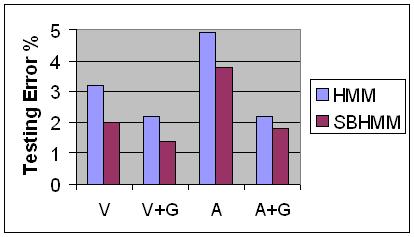
V:
vision-based MIT data, A: accelerometer-based Georgia Tech data, and G: using
grammar for postprocessing.
-
Georgia Tech Gait Recognition data
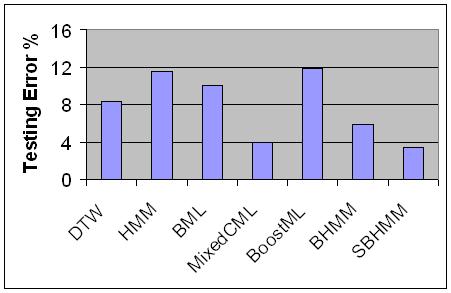
The performance for DTW, HMM, BML, MixedCML, BoostedML
are directly from [Kim and Pavlovic, 2006]. BHMM is boosted HMM in [Yin, et.al.,
2004]. Please refer to these two papers for the details of the data and the
experiments conducted.
-
Georgia Tech Audio-Visual Speech Recognition Data
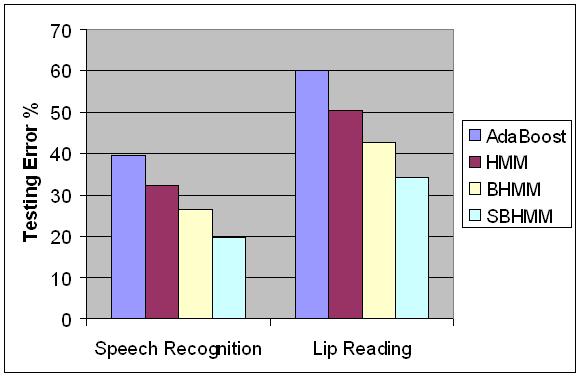
In this
chart, we report the testing error for phoneme recognition. We only use audio
information in speech recognition and visual information in lip reading. Note
that audio-visual fusion may further reduce the recognition error as in [Yin,
et.al., 2003]. For the details of the data and the experiments conducted, please
refer to [Yin, et.al., 2004] and [Yin, et.al., 2008].
Publications
Pei Yin,
Irfan Essa, Thad Starner, James M. Rehg, "Discriminative Feature Selection for
Hidden Markov Models Using Segmental Boosting", in Proc. of IEEE International
Conference on Acoustics, Speech, and Signal Processing (ICASSP 2008), Mar. 2008.
(pdf) (bibtex).
Pei Yin,
Irfan Essa, James M. Rehg, "Segmental Boosting Algorithm for Time-series
Analysis," in Snowbird Machine Learning Workshop, Mar. 2007.
Pei Yin, Irfan Essa, James M. Rehg,
"Asymmetrically Boosted HMM for Speech Reading," in Proc. of IEEE
Conference on Computer Vision and Pattern Recognition (CVPR 2004), pp
II755-761, June 2004
(pdf) (bibtex)
Pei Yin, Irfan Essa, James M. Rehg,
"Boosted Audio-Visual HMM for Speech Reading," in Proc. of IEEE
International Workshop on Analysis and Modeling of Faces and Gestures (AMFG),
pp 68-73, Oct. 2003/held in conjunction with ICCV-2003.
A version of this paper also appears in Proc. of Asilomar Conference on
Signals, Systems, and Computers, pp 2013-2018, Nov. 2003 as an invited paper.
(pdf)
(bibtex)
Acknowledgements
We would like to thank Professor Biing-Hwang (Fred) Juang for his guidance with some of the acoustic processing parts
of this research, Professor Aaron Bobick, Jianxin Wu, Qiang Fu, Matthew Mullin,
Zhenhao Zhou, Yifan Shi, Jie Sun and Fabien Robert for the discussions, and our subjects for volunteering their time. This project is partly funded by
National Science Foundation ITR grant #IIS-0205507
and IIS#0511900.
Code Download
Integrated with HTK
(coming soon)
Last Updated Apr. 7, 2008.







